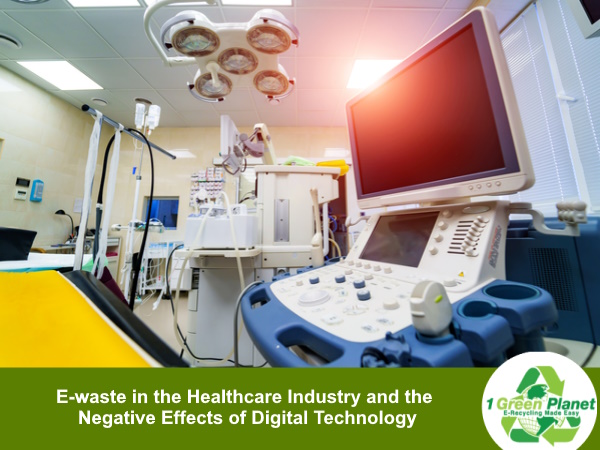Published on March 6, 2023, Updated on March 20, 2023
As numerous industries move forward with zero-waste initiatives, healthcare leaders are anxious to generate results via digitalization while traversing a growing environmental consciousness.
According to the World Economic Forum, we as a species produce approximately 48,5 million metric tons of e-waste annually on a global scale. How much of the world’s waste stream with the quickest growth rate is generated by healthcare? Is it possible to separate the digital transformation of healthcare from e-waste and the negative effects of digital technology?
What Does E-waste in the Healthcare Industry Look Like?
Currently, it is difficult to determine the exact amount of electronic waste generated by the healthcare industry, but it is not difficult to assess the scope of its contributions. Electronic waste encompasses a vast array of materials. This includes:
- Computer components
- Printers
- Electrocardiogram machines and monitors
- Lab analyzers
- Imaging equipment (X-ray, MRI, CT scanners, and ultrasound)
- Cathode ray tubes and liquid crystal displays
- Mobile phones
- Tablets
- Batteries and resistors
With over 6,093 hospitals in the United States alone, the amount of e-waste produced by the industry is staggering, especially considering the inherent depletion of many devices and the industry’s steady progression toward a more digital future.
The Internet of Medical Equipment
The “internet of medical things” is the only place in healthcare where the question of wastefulness may be more pertinent than elsewhere. According to the World Health Organization, there are approximately 2 million unique types of medical devices on the market today, classified into over 7,000 generic device groups. How can these devices be handled and discarded in an ethical manner?
Reselling these devices is an option, but the question of secure disposal and repurposing is crucial in healthcare, especially as the industry continues to lead in data breaches.
The Reality Regarding Digital Transformation
Some aspects of digital transformation may reduce the nearly 2 billion pounds of paper and cardboard waste that healthcare facilities produce annually, but digital is not inherently “greener.”
The footprint of the data center grows for every hospital that goes paperless. The energy demands of data centers are huge, which leads to an unintended but unbridled negative consequence of digital technology.
The Data Center of the Hospital Industry
Local and regional electricity prices are complex, but we can anticipate an increase in part due to renewable energy. According to an analysis by Research and Markets, this is the amount of energy required to manage the 2,314 exabytes of data that the industry is expected to collect, process, and store this year. The primary location of this expansion is the hospital’s data center.
The demand for data storage and computational capacity over the past decade has doubled every 4 years. This growth is substantial because data centers are projected to have a greater carbon footprint than the whole aviation industry. This is largely a result of locations with hotter climates requiring more energy to maintain optimal temperatures in data centers.
Hospitals and healthcare institutions that advance in the direction of sustainability and take steps to counteract the negative effects of digital technology can anticipate financial gains. In the future, hospital administrators can anticipate an increase in sustainability practices and a more thoughtful approach to digital innovation. Leaders in the healthcare industry should evaluate their participation in zero-waste movements within the industry.
1 Green Planet handles the ethical waste of all your old and unwanted electronics and equipment. Call us to schedule a pickup. see the areas we serve














